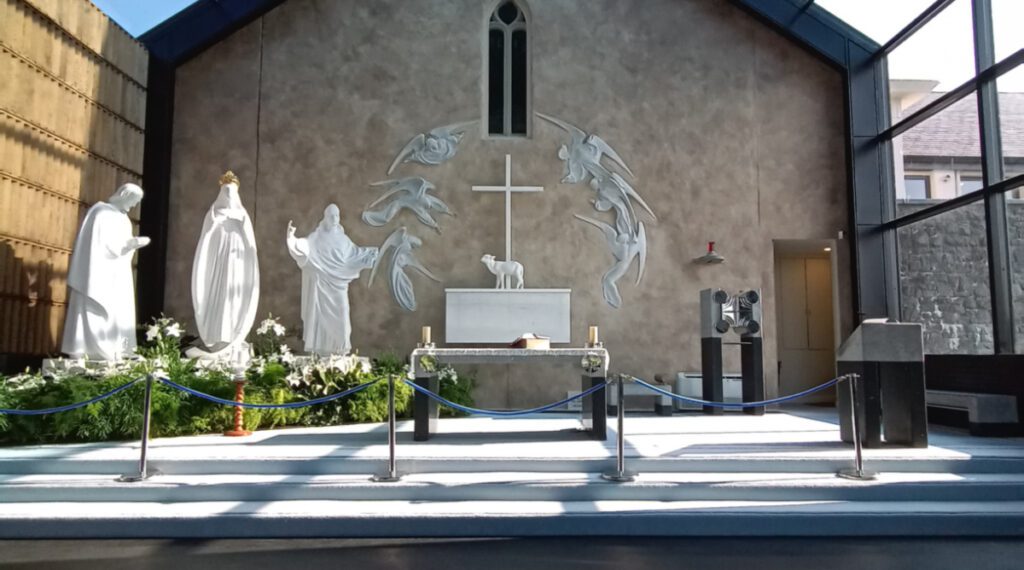Editor’s note: This is part 28 of a series, “The Kingdom of Grace.” Part 27 can be found here.
It was the evening of August 21, 1879. In the little village of Knock in western Ireland, a group of more than twenty people stood in the midst of a heavy downpour. They were witnessing a vision of heavenly figures made of light appearing on the gable wall of Saint John the Baptist Church. The luminous figures spoke no words but held their posture in place for over two hours. As people looked on, some went to tell others, some remained in prayer, some tried to touch the figures in the apparition. The attempt to touch them proved futile. Hands simply passed through light to feel the stone wall of the Church. The witnesses, who were later examined by ecclesiastical authorities and declared trustworthy, offer a common description of what they saw.
On the far left was Saint Joseph with hands folded in prayer. Next to him was Our Lady wearing a crown of gold, her eyes and hands lifted upwards to heaven in prayer. Next to her was Saint John the Evangelist wearing something like a Bishop’s mitre. His one hand was holding a book of the gospels; his other hand was lifted up as though preaching. Next to Saint John, however, was the central and brightest figure in the whole scene. Standing erect on a raised altar, there was a bright white Lamb, head lifted high. Above the Lamb was a radiant cross. The altar, the Lamb, and the cross were surrounded by luminous angels. The vision lasted about two hours, and popular piety refers to the event as a Marian apparition. That is partially true, but the larger truth is that it was a Eucharistic apparition.
Recently, I made a pilgrimage to Knock. Over the very place where the apparition took place, against the same gable wall of the same Church, one now finds the “apparition chapel.” The chapel has large white statues of each figure, carved according to the instructions of one of the original eyewitnesses, all arranged in place to replicate the vision. The focal point is the Lamb. The Lamb stands erect on an altar fastened high on the wall, but on the ground below stands another altar for the celebration of Mass and Adoration.
When I first arrived, I entered the apparition chapel during Eucharistic Adoration. Tired from travel yet overjoyed to arrive, I sat down directly in the center of the chapel to take in the awesome sight of the white figure of the Lamb on the elevated altar. I pondered how wonderful it must have been for the visionaries actually to see the Lamb made of light – wholly luminous – to catch a glimpse into heaven like Saint John of old on the isle of Patmos. But gradually my eyes descended from the white statue of the Lamb, and fell upon the host in the monstrance beneath it.
At that moment, looking now at the consecrated host, something like thunder clapped in my soul.
Instantly, I realized how every day of my life as a priest I take into my hands the actual Lamb of God, lift him up before the people, and say: “Behold, the Lamb of God.” The people see neither a luminous figure of the Lamb nor a stone replica, but the actual Lamb of God in my hands. I asked myself: how many times have I lifted up the Lamb without really realizing what I was doing or saying? In that moment, in the light of grace, I realized what a great thing it is for anyone to behold the Lamb of God even once during the elevation at Mass.
It is a far greater thing than the most extraordinary of mystical visions.
It is a far greater thing than the most extraordinary of mystical visions.
It was Saint John the Baptist who first proclaimed: “Behold the Lamb of God!” It is holy mother Church who joins his words to the Eucharist during the final elevation at Mass. The wisdom of joining the prophetic words of Saint John to their fulfillment in Jesus Christ present in the Eucharist is most sublime. It is a summons to contemplation. A good mother points things out to her children, and tells them what they are seeing so that they might look and learn the world. “Look,” a mother says to her children, “a blue jay.” Similarly, holy mother Church holds up the Eucharist and says “Behold, the Lamb of God.” The sight and the lesson are far too much for the soul to take in all at once. The elevation of the Eucharist is a passing moment, and necessarily a brief one, in preparation for holy communion. Even repeated celebrations of the Mass, even many glances upon the elevated host together with the command to behold the Lamb of God, are not enough to internalize the truth the moment contains. All too often, the gesture can become routine, and perhaps the moment even becomes mindless.
In order to capture the sublime wisdom set before us in the words and gesture of the elevation, in order to linger in the light of the immense truth that the moment contains, the practice of Eucharistic Adoration has developed over the centuries. Eucharistic Adoration is basically a prolongation of the final elevation at Mass, but a prolongation of the moment outside of the Mass, so that we might heed at greater length the call of John the Baptist to behold. Eucharistic Adoration is essentially a sustained beholding of the Lamb of God. It is also the perfect response to the forerunner’s prophetic command: metanoeite! Mind your God!
We grow in grace by walking the pathways of metanoia. We take up practices by which the eyes of our hearts are turned from preoccupation with lesser things to the sight of higher things – to supernatural mysteries and heavenly sights coming down to us even now from “the Father of lights” (Jas. 1:17). Of all the gifts coming down to us from on high, none is greater than the Eucharist. The Lamb of God is in our midst, on our altars, in our tabernacles. How could love fail to pay him any notice? How could love not want to mind him for a good long period of time?
Eucharistic Adoration is a school of contemplation. It is a simple way for busy people to let go of their busy-ness, to step back from the rat race that our lives have become, and to recenter on what really matters in life. What really matters is God. In Eucharistic Adoration, the Lamb of God is silent, but his silence speaks louder than words. From the silence of the monstrance, the Lamb speaks to the heart of a Love beyond all telling. He tells of the Love that drove him to the cross, to the tomb, and to the third day resurrection. Slowly, with practice, beholding the Lamb of God grows into beholding the heart that has so loved men.
In the vision at Knock, they say, the Lamb was the brightest figure of them all. Do you, too, want to see the luminous Lamb? Seek him in a monstrance near you.
There you will find him before your very eyes.
_______________________________
Father James Dominic Brent, O.P. is a Dominican Friar who lives and teaches at the Dominican House of Studies in Washington, DC. He is the author of The Father’s House: Discovering Our Home in the Trinity. He posts select homilies, spiritual conferences, interviews, and radio spots on his personal Soundcloud Site. He frequently lectures for the Thomistic Institute, and appears on Aquinas 101.
Photo of the Apparition Chapel at Knock, Photo Courtesy of Father James Dominic Brent, O.P.




